If you want to pursue the best hobby in the world even in the winter, but would rather reserve clay masks for the wellness studio, you need a mudguard for your MTB. We tested the most popular models to find out what you should look for in a mudguard, and whether they can deliver what they promise.
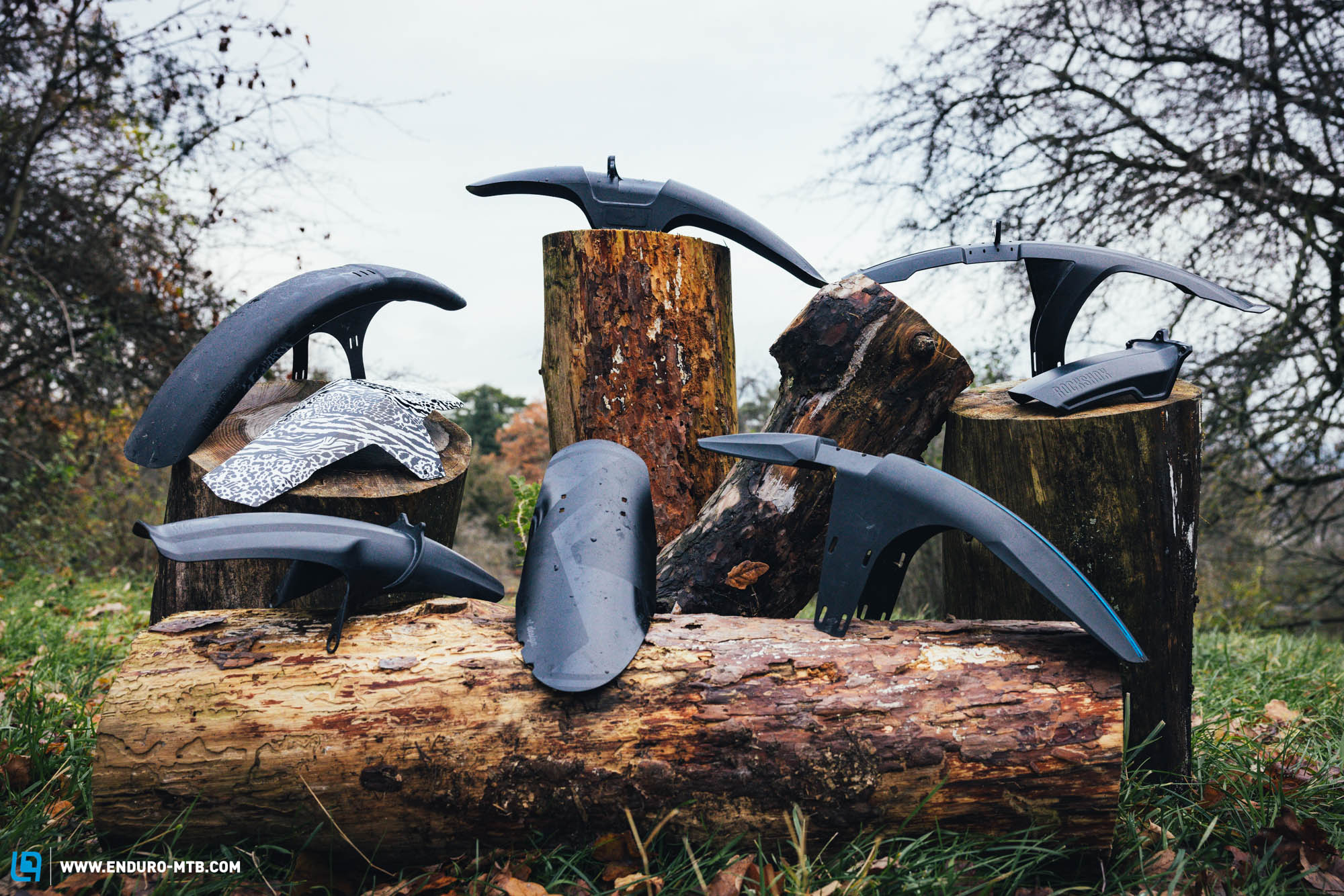
Mountain bikers can generally be split into two groups in the winter or in bad weather. The first group battles slick roots and mud in the woods, while the second one prefers chilling on the couch with a cup of tea, or tries other sports, like indoor swimming or bouldering. Although we also find ourselves bouldering a lot more in the winter, we still ride our bikes at every opportunity and recommend that you do the same. But why face the cold, mud, and slippery trails? Quite simply because it’s damn fun. It improves your riding skills, and it can make even the easiest home trails demanding again. Regular rides allow you to maintain or maybe even improve your fitness, making it easier to start the summer season. You can also unleash your inner child and splash through every puddle, whether in a drift or manual. Of course, there are a few things to keep in mind when riding in the winter: we recommend waterproof riding kit so that you don’t get soaked through, and wearing many layers to ward off the cold. Neoprene socks are cheaper than a pair of new waterproof shoes, and they work just as well in keeping your toes warm. But the most important thing, of course, is to keep the mud out of your eyes. Regardless of how muddy and wet the trail, you shouldn’t ride without eyewear and a mudguard, because it doesn’t matter how dry and warm you are if you can’t see where you’re going, putting a considerable damper on the fun. But there are big differences between the mudguards available on the market. Therefore, we took a closer look at the most popular and promising models, helping you find the perfect mudguard for your bike and use case.

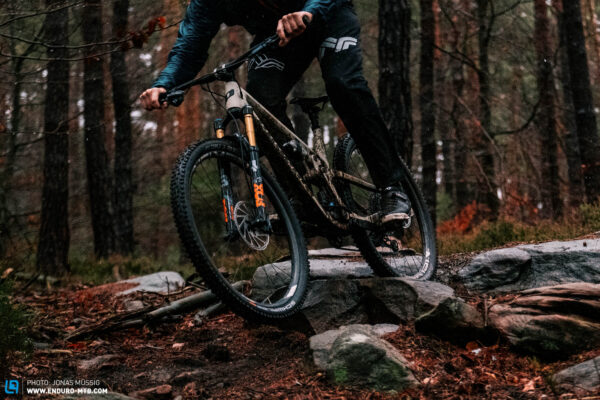

What do we look for in a mudguard?
By far the most important task of a mudguard is to keep the mud off of your face and out of your eyes. We don’t know about you, but we don’t like stopping every few metres to wipe the dirt out of our eyes or clean our glasses. What’s almost as annoying as mud in your eyes is a bike that rattles. That’s why the mudguard shouldn’t rattle or make any other noises. Unfortunately, this often comes at the cost of easy and, above all, quick installation. We want to be able to attach the mudguard in the parking lot on a rainy day without having to get our toolbox out of the car first. To keep your fork somewhat protected despite the muddy conditions, the mudguard should also prevent dirt from getting to your fork seals. And while we’re on the subject of protecting your expensive fork, the mudguard shouldn’t scuff the paint on the lower legs either, of course. The material also plays a major role. It should be flexible enough to let the mudguard bend instead of break in a crash, but stiff enough that it doesn’t wobble when you ride. However, our requirements of the material don’t stop there. Mudguards are fairly simple, which allows them to be made of recycled plastic without too much extra effort.
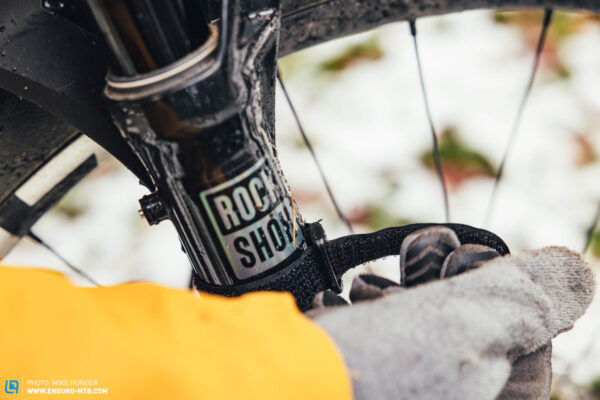

Our mudguard test field at a glance
We compared 8 different models for our big mudguard group test. Some of the differences in our test field were very large, like the length, for example. At just 180 mm, the shortest candidate comes from RockShox. Measuring 595 mm, the mudguard from Mucky Nutz is a whole 415 mm longer. Meanwhile, their weight differs by 105 g. Anyone who suspects that most mudguards and the longest models come from the rainy island is right, at least in the second point. Just as many of the mudguards on test come from manufacturers in the wet UK as from other countries. Below you’ll find an overview of our test field.
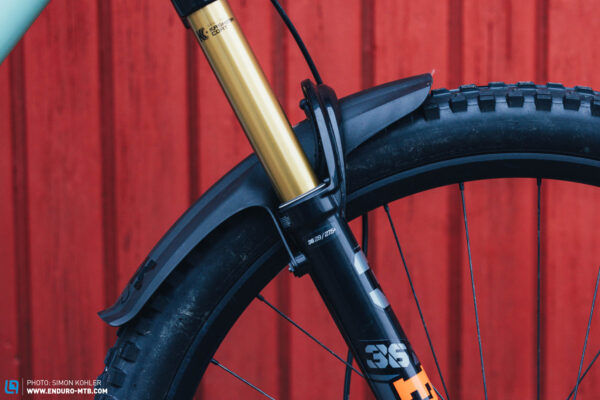
Price: € 36 | Weight: 93 g | Length: 350 mm

Price: £ 25 | Weight: 106 g | Length: 595 mm
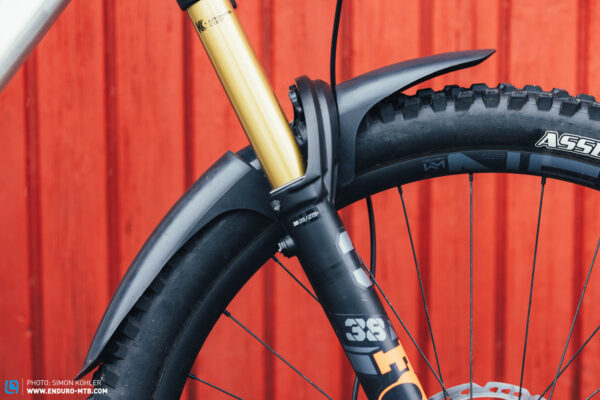
Price: € 43.99 | Weight: 127 g | Length: 510 mm
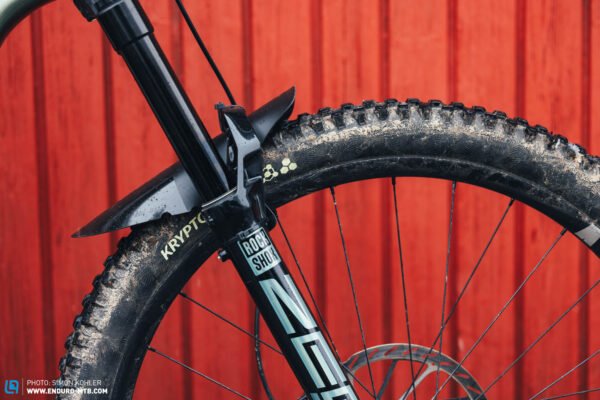
Price: € 14.95 | Weight: 51 g | Length: 280 mm
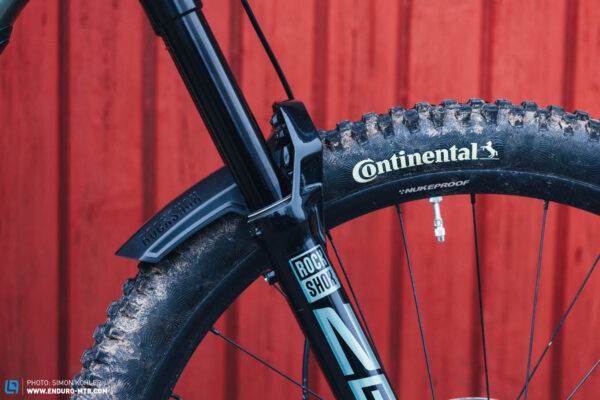
Price: € 25 | Weight: 42 g | Length: 180 mm
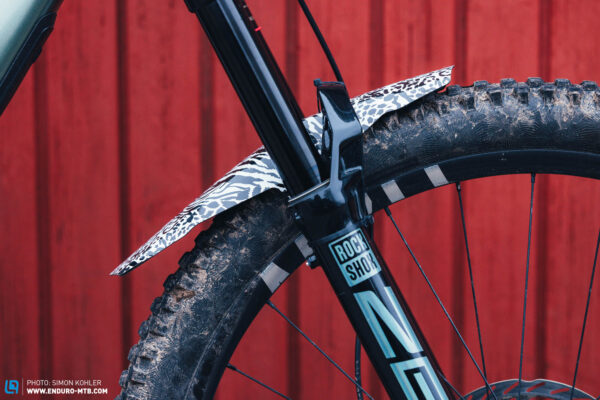
Price: € 23.90/29.90 | Weight: 52 g | Length: 350 mm
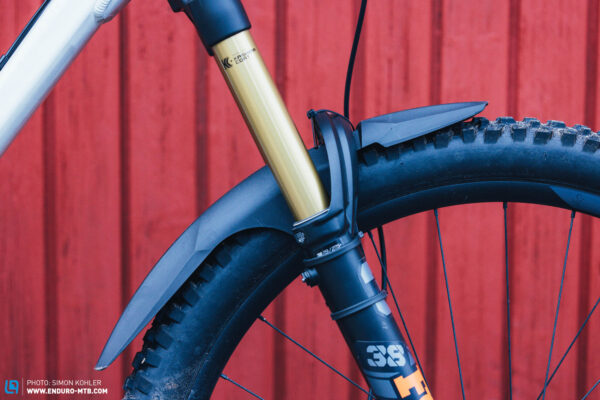
Price: € 16.95 | Weight: 135 g | Length: 480 mm
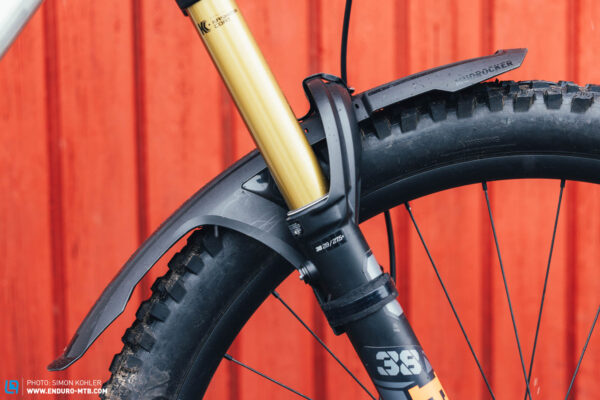
Price: € 29.99 | Weight: 120g–147 g | Length: 490 mm
Does mudguard length matter?
In short, yes. But to provide the best possible protection, there are other factors, such as the mudguard width or how well the tire is enclosed by the mudguard. Longer mudguards clearly offer better protection. However, short mudguards are still more common on the trail than their longer rivals. On the one hand, this is because the long models can’t be left on the bike since no one wants to ride with a long mudguard in the summer. Small mudguards are unobtrusive, so you don’t run the risk of being stopped by the style police. A mudguard can also be a problem in bike parks. On many modern chairlifts, the front wheel hooks into a bracket. This isn’t always compatible with long mudguards, and they end up breaking. Probably the biggest argument for shorter mudguards that simply stay on the bike all year round is that it can also rain in the summer. Although they’re a lot less protective than the larger models, they’re still a whole lot better than riding in the rain with no mudguard at all.

Which mudguard will fit on your bike?
First of all, the good news: all mudguards are compatible with 26, 27.5 and 29 inch wheels. The mudguards’ maximum tire width of at least 3 inches is also sufficient for most common tires, which usually range between 2.4 and 2.6 inches wide. The bad news: not every mudguard is compatible with every fork. This applies to the bolt-on models in particular. The models from RockShox and FOX only fit their own forks, and only the new models. Things look much better at Mudhugger. Thanks to various adapters, the EVO Bolt-On is compatible with a variety of forks, with the exception of the RockShox Lyrik. Of course, the mudguards that rely on Velcro or cable ties are the most widely compatible. Thanks to a large number of mounting points, these mudguards fit all common suspension forks on the market. In addition to the models from market leaders FOX and RockShox, they can also be attached to forks from smaller brands like BOS, DVO, EXT, Öhlins, and Formula. The only exceptions here are unique forks like the Manitou Mezzer with its backward facing fork crown, or upside-down forks like those from Intend or Bright.
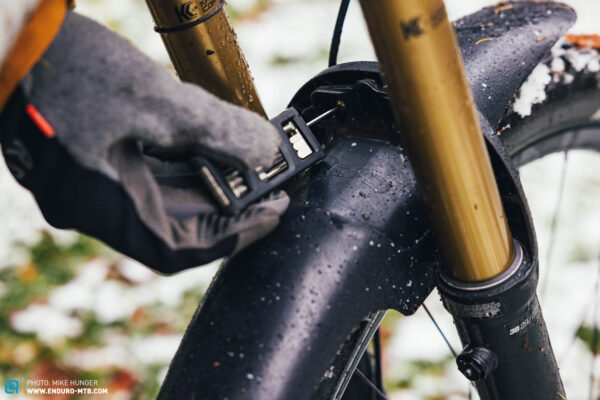

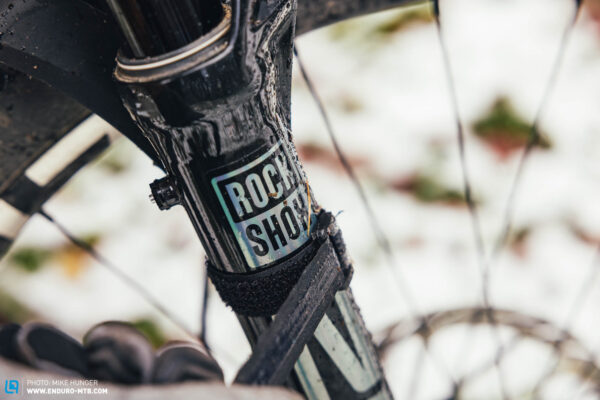
How do the mudguards attach to the bike?
The mudguard attachment can basically be divided into two different methods: strap or bolt-on. For the strap-on models, you can further distinguish between cable ties and Velcro. Like everything in life, each variant has its own advantages and disadvantages. The biggest disadvantage of bolt-on mudguards is their limited compatibility. You need a current fork model with threads in the back of the bridge, and a matching mudguard. Moreover, you’ll need an Allen key for the small screws, which are usually rather fiddly to deal with. In return, you get a clean look and don’t have to worry about scratching your fork. That’s the biggest problem with the strap-on models. These types of mudguards always rub slightly against the fork, no matter how tightly you cinch them down, eventually damaging the paint. This can be remedied with protective film on the lowers and foam padding on the fork bridge. If you frequently remove and replace the mudguard on your bike, the cable tie models also generate a lot of waste. That said, you get easy installation and they’re compatible with most forks. The differences to Velcro straps are small, apart from the attachment, which is tool-free and fast. Velcro straps are best suited to situations where you’ll only leave the mudguard on the bike for a short time. All the mudguards on test with Velcro straps can also be attached with cable ties. Unfortunately, not all cable tie models can be attached with Velcro straps because the mounting points for cable ties are a lot smaller.
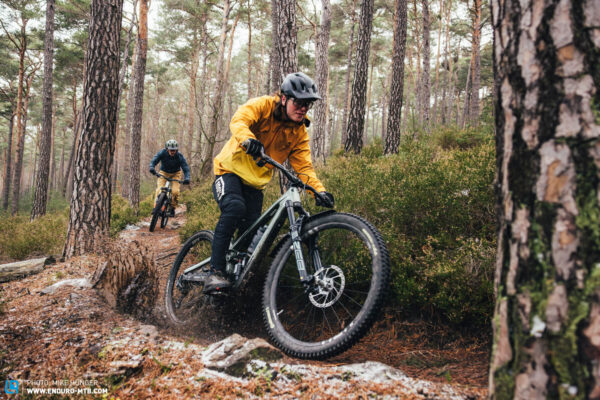
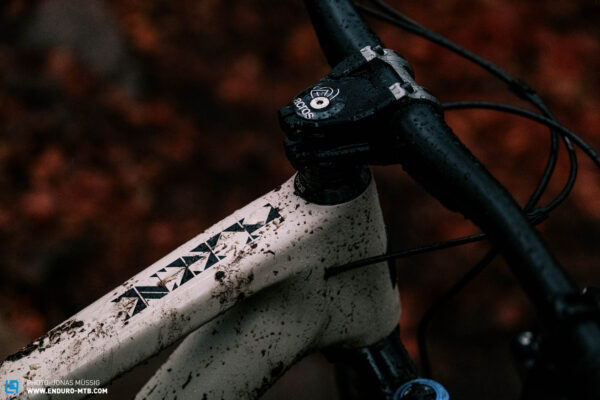

How did we test the mudguards?
We seized every opportunity to test the mudguards on our home trails over the past few months. This ranged from weekend trips to special test rides. To test them in as many scenarios as possible, the ground was still so dry and dusty on the first test rides that we had problems seeing the trail in front of us. But the weather changed soon enough and the mudguards became indispensable companions on all our rides. The trails alternated between wet and very wet, and for a change we looked at the weather and hoped for rain! To compare the protective effect of the individual mudguards as accurately as possible, we also tested each mudguard back to back in one day. We looked for the muddiest trail we could find, which can be a challenge on our home trails in Stuttgart. At this time of year, the trails try to outdo each other with the deepest mud and largest puddles.
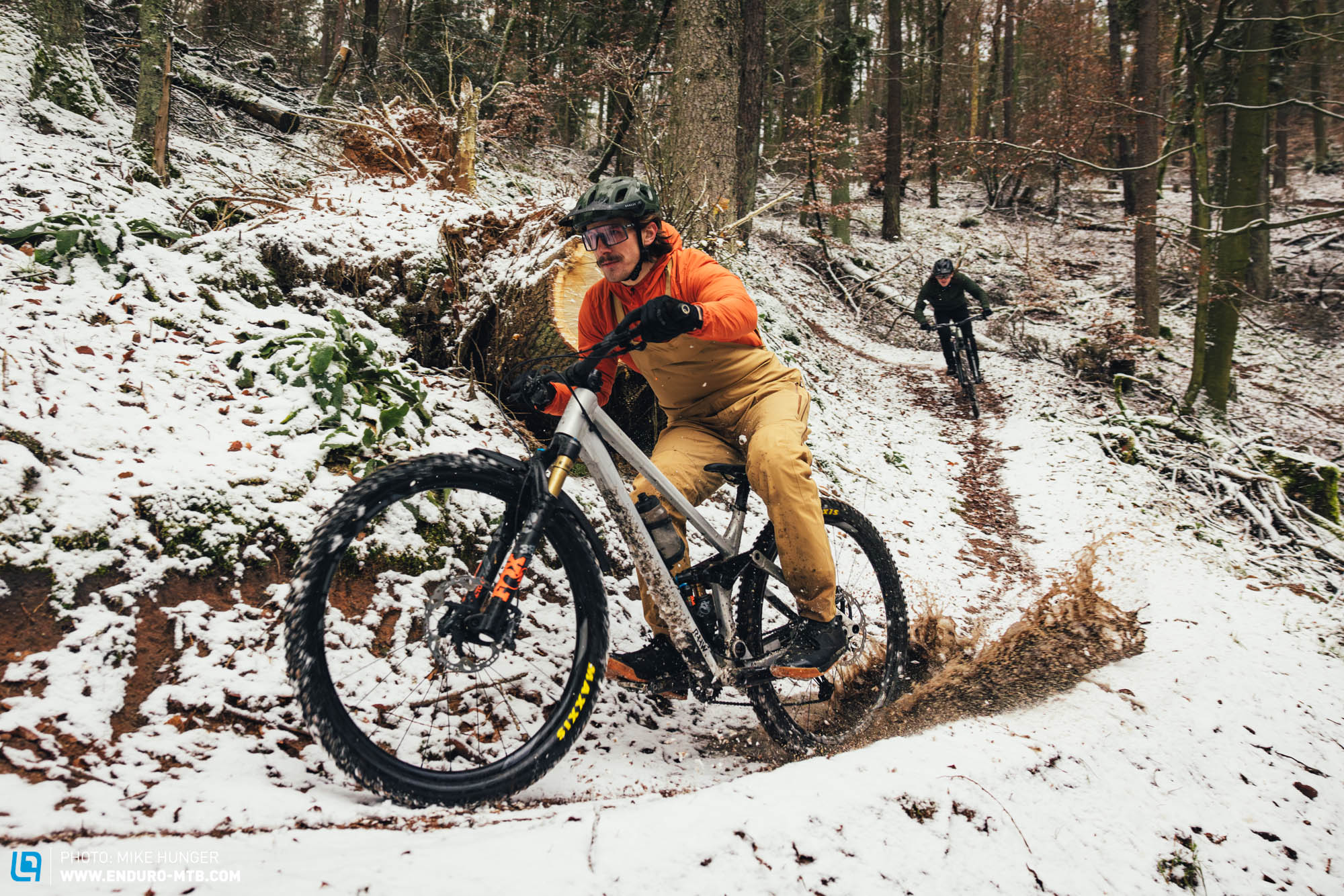
The tops and flops of our mudguard group test
Tops
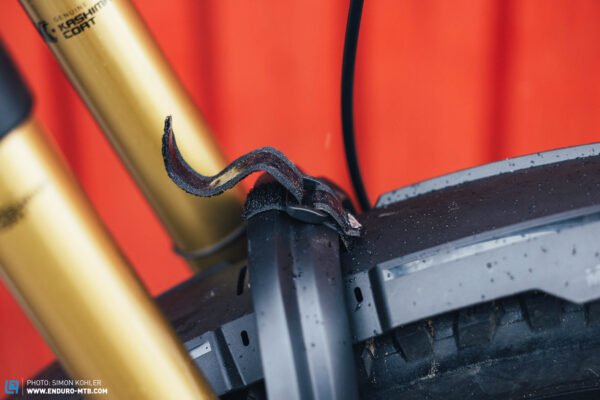



Flops



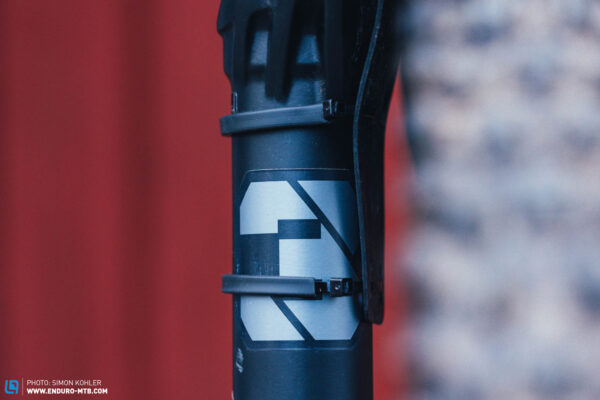
The test field at a glance
The RockShox Fender (Click for review) is the smallest model in the group test. Thus, it also offers the least protection, and appeals more to minimalists who want to ride with the mudguard all year round.
With the Riesel Design kol:oss (Click for review), the small German brand rely on the classic mudguard construction. It doesn’t offer as much protection as the larger mudguards, but it’s still better than no mudguard at all. Just like the RockShox Fender, it appeals to the minimalists among us.
The FOX Mudguard (Click for review) is nicely integrated into the fork. In terms of protection, it’s in the upper midfield of our test, just like its length. It’s only the comparatively long and time-consuming attachment of the FOX Mudguard that lags behind the competition.

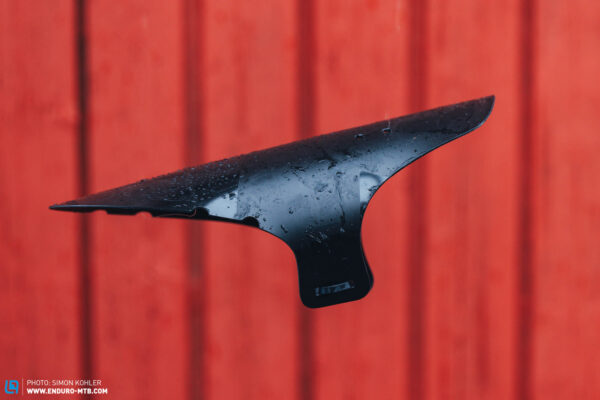
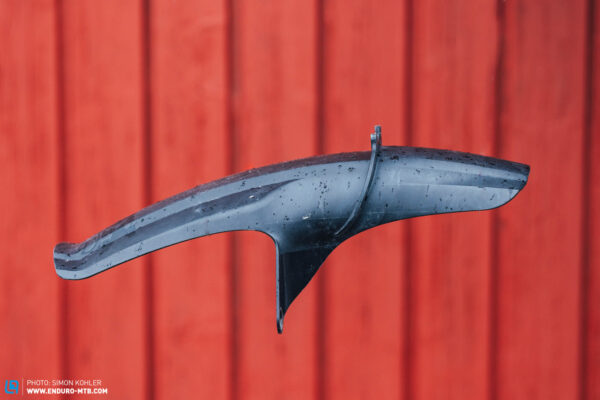
The Zéfal Deflector FM30 (Click for review) offers good protection at a fair price. The installation is quick thanks to cable ties, though other mudguards are better suited for frequent mounting and dismounting.
From the rainy island comes the Mucky Nutz MugGuard Long (Click for review). The MugGuard provides the best protection in the test, and it attaches with the included Velcro straps. However, these make installing the mudguard somewhat difficult, and allow it to rattle on the trail.

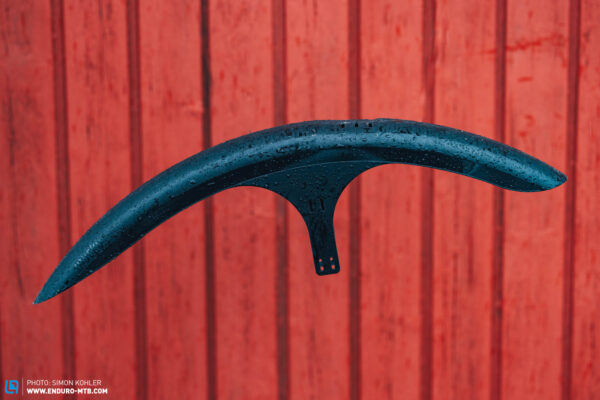
The Mudhugger EVO Bolt-On (Click for review) is the only bolt-on option on test that’s compatible with different forks once proper adapters are used. It also comes in second place in terms of protection. However, the Mudhugger fell short of the test victory due to slight rattling and it being the most expensive mudguard on test.
The Slicy Enduro/DH Long mudguard (Click for review) appeals mainly to the individualists among us. In addition to various designs, they offer an online configurator with which you can customise the mudguard with your own personal touch.

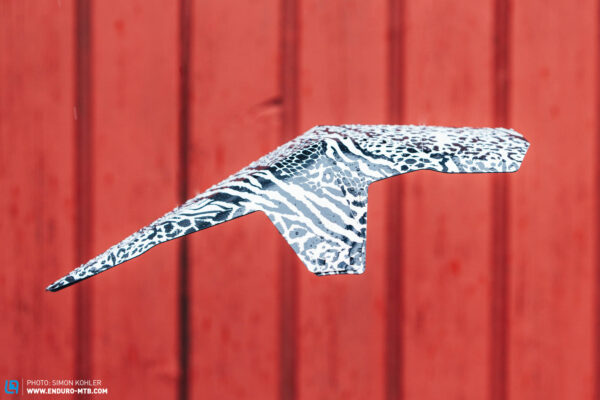
The best mudguard on test – SKS MUDROCKER FRONT
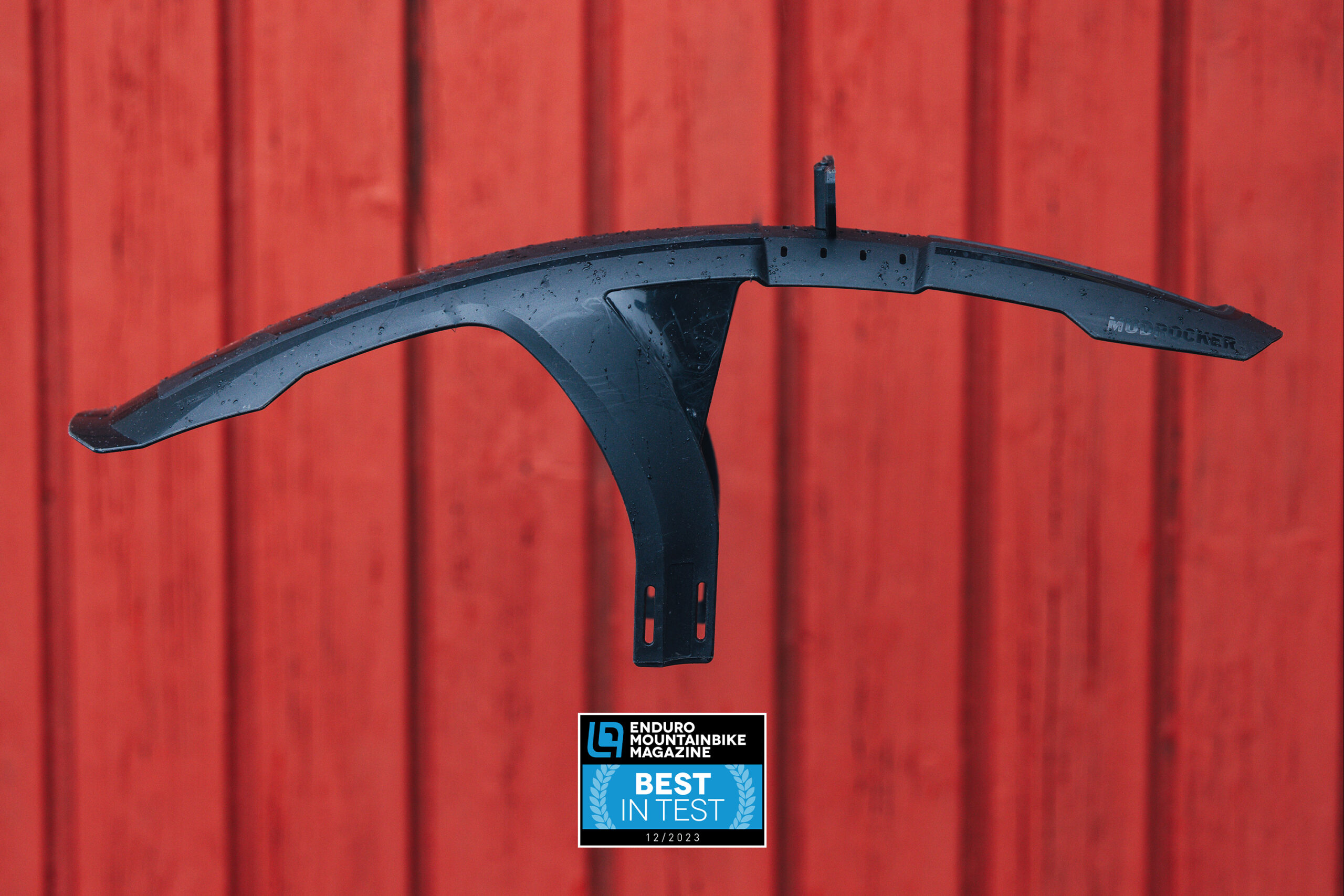
The MUDROCKER from SKS (Click for review) was performed convincingly throughout. It provides excellent protection for both your face and fork seals. Thanks to the Velcro straps, it’s also the quickest and easiest to mount, requiring no tools. That way you can quickly attach the mudguard to the bike on a rainy day. As the days get shorter, you can also leave the MUDROCKER permanently attached to your bike with cable ties or screws. The MUDROCKER shouldn’t scratch your fork either thanks to the enclosed protective tape. The well-deserved Best in Test!
Conclusion and findings from our mudguard group test
All the mudguards on test offer a decent level of protection and fend off the worst of the mud. Thanks to their universal shape, they’re compatible with all wheel sizes, but not every fork – so check that before buying. Even though they look very similar at first glance, there are big differences in how they attach and how well they protect. Ease of attachment is particularly important for the large models, allowing you to install and use them as needed. Due to their higher weight, however, they tend to rattle. Longer mudguards offer better protection, while the shorter models are less conspicuous and can therefore stay on the bike year-round – ideal for an unexpected summer downpour.
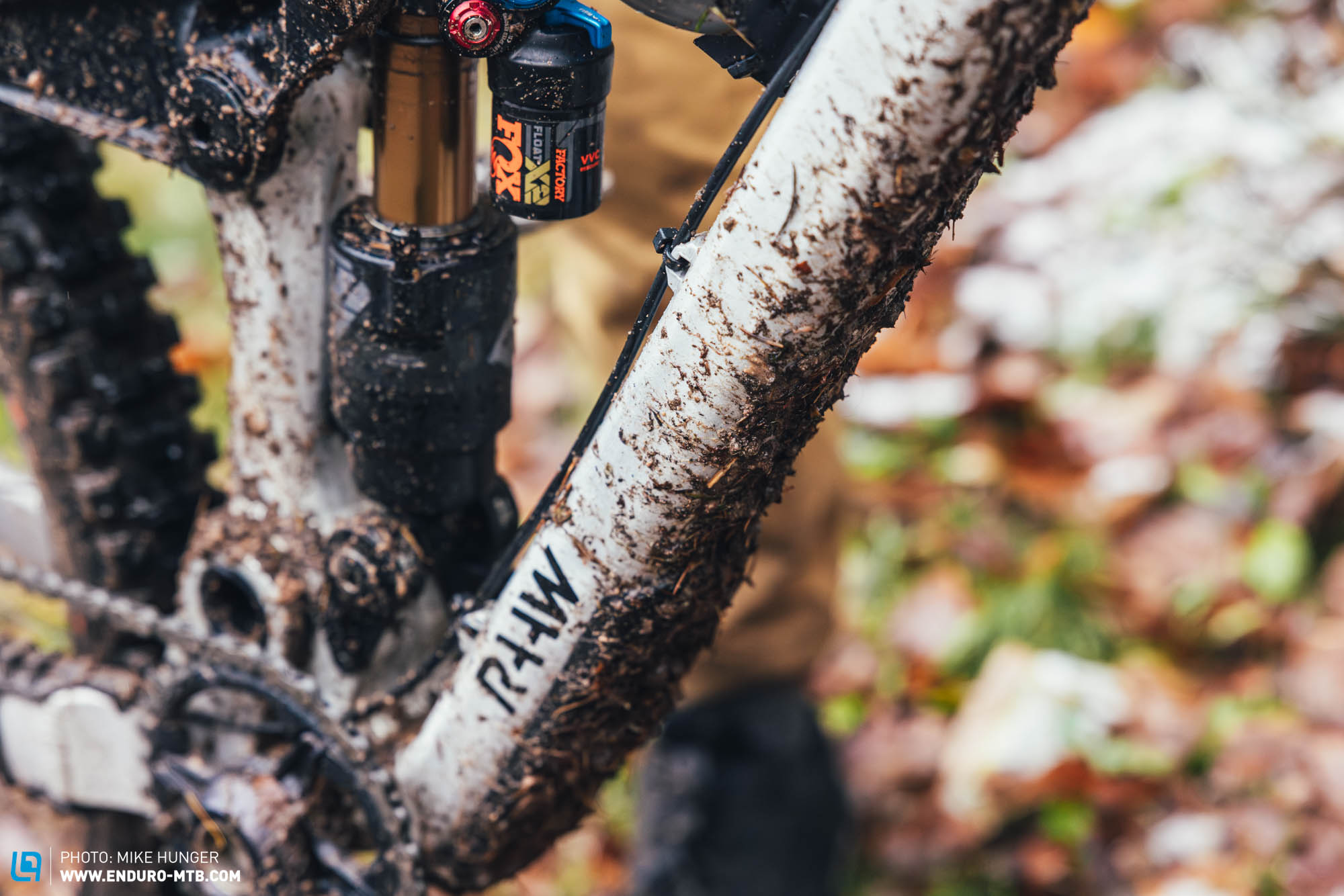
Did you enjoy this article? If so, we would be stoked if you decide to support us with a monthly contribution. By becoming a supporter of ENDURO, you will help secure a sustainable future for high-quality mountain bike journalism. Click here to learn more.
Words: Sebastian Dirscherl Photos: Simon Kohler, Mike Hunger, Jonas Müssig, Peter Walker









